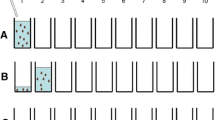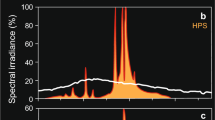Abstract
We demonstrate that zooplankton escape abilities are consistent with the composition of the zooplankton community in the Great Lakes following the invasion of the visually preying invertebrate predator Bythotrephes longimanus. Escape abilities were analyzed by videotaping responses of free-swimming zooplankton to encounters with tethered Bythotrephes. Both maximum speed and maximum acceleration of the escape response were appreciably greater in Daphnia mendotae and diaptomids, whose populations remained relatively unchanged, than those of Daphnia retrocurva and Daphnia pulicaria, whose populations greatly decreased after the Bythotrephes invasion. Maximum speed of all species was higher in the light than in complete darkness, likely due to a different level of activity of Bythotrephes. Contrary to treatments with Bythotrephes, mean and maximum swimming speeds of all species were similar to each other and the same in light and dark in treatments without Bythotrephes. This implies that the prey were responding to infochemicals produced by Bythotrephes.



Similar content being viewed by others
References
Barbiero RP, Tuchman M (2004) Changes in the crustacean communities of Lakes Michigan, Huron, and Erie following the invasion of the predatory cladoceran Bythotrephes longimanus. Can J Fish Aquat Sci 61:2111–2125
Brewer MC, Coughlin JN (1996) Virtual plankton—a novel approach to the investigation of aquatic predator-prey interactions. Mar Freshw Behav Physiol 26:91–100
Brewer MC, Dawidowicz P, Dodson SI (1999) Interactive effects of fish kairomone and light on Daphnia escape behavior. J Plankton Res 21:1317–1335
Bundy MH, Vanderploeg HA (2002) Detection and capture of inert particles by calanoid copepods: the role of the feeding current. J Plankton Res 24:215–223
Bundy MH, Gross TF, Vanderploeg HA, Strickler JR (1998) Perception of inert particles by calanoid copepods: behavioral observations and a numerical model. J Plankton Res 20:2129–2152
Dodson SI (1974) Zooplankton competition and predation: an experimental test of the size-efficiency hypothesis. Ecology 55:605–613
Dodson S, Ramcharan C (1991) Size specific swimming behavior of Daphnia pulex. J Plankton Res 13:1367–1379
Dodson SI, Ryan S, Tollrian R, Lampert W (1997) Individual swimming behavior of Daphnia—effects of food, light and container size in four clones. J Plankton Res 19:1537–1552
Dumitru C, Sprules WG, Yan ND (2001) Impact of Bythotrephes longimanus on zooplankton assemblages of Harp Lake, Canada: an assessment based on predator consumption and prey production. Freshw Biol 46:241–251
Gerritsen J, Strickler JR (1977) Encounter probabilities and community structure in zooplankton - mathematical model. J Fish Res Board Can 34:73–82
Gliwicz ZM, Pijanowska J (1989) The role of predation on zooplankton succession. In: Sommer U (ed) Plankton ecology: succession in plankton communities. Springer, New York, pp 253–296
Lampert W, Tollrian R, Stibor H (1994) Chemical induction of defense mechanisms in freshwater animals. Naturwiss 81:375–382
Lass S, Spaak P (2003) Chemically induced anti-predator defences in plankton: a review. Hydrobiologia 491:221–239
Lehman JT (1991) Causes and consequences of cladoceran dynamics in Lake Michigan implications of species invasion by Bythotrephes. J Great Lakes Res 17:437–445
Lehman JT, Cáceres CE (1993) Food web responses to species invasion by a predatory invertebrate Bythotrephes in Lake Michigan. Limnol Oceanogr 38:879–891
Makarewicz JC, Bertram P, Lewis T, Brown EH (1995) A decade of predatory control of zooplankton species composition of Lake Michigan. J Great Lakes Res 21:620–640
Muirhead J, Sprules WG (2003) Reaction distance of Bythotrephes longimanus, encounter rate and index of prey risk for Harp Lake, Ontario. Freshw Biol 48:135–146
O’Keefe TC, Brewer MC, Dodson SI (1998) Swimming behavior of Daphnia—its role in determining predation risk. J Plankton Res 20:973–984
Pangle KL, Peacor SD (2006) Non-lethal effect of the invasive predator Bythotrephes longimanus on Daphnia mendotae. Freshw Biol 51:1070–1078
Pangle KL, Peacor SD, Johannsson OE (2007) Large nonlethal effects of an invasive invertebrate predator on zooplankton population growth rate. Ecology 88:402–412
Pijanowska J, Dawidowicz P, Weider LJ (2006) Predator-induced escape response in Daphnia. Arch Hydrobiol 167:77–87
R Development Core Team (2010) R: a language and environment for statistical computing. R foundation for statistical computing, Vienna, Austria. http://www.R-project.org
Schulz KL, Yurista PM (1999) Implications of an invertebrate predator’s (Bythotrephes cederstroemi) atypical effects on a pelagic zooplankton community. Hydrobiologia 380:179–193
Strickler JR (1985) Feeding currents in calanoid copepods: two new hypotheses. In: Laverack MS (ed) Physiological adaptations of marine animals. Society of Experimental Biology, UK, pp 459–485
Titelman J, Kiørboe T (2003) Predator avoidance by nauplii. Mar Ecol Prog Ser 247:137–149
Vanderploeg HA, Liebig JR, Omair M (1993) Bythotrephes predation on Great Lakes zooplankton measured by an in situ method implications for zooplankton community structure. Arch Hydrobiol 127:1–8
Visser AW (2001) Hydromechanical signals in the plankton. Mar Ecol Prog Ser 222:1–24
Weber A, Van Noordwijk A (2002) Swimming behaviour of Daphnia clones: differentiation through predator infochemicals. J Plankton Res 24:1335–1348
Yan ND, Pawson TW (1997) Changes in the crustacean zooplankton community of Harp Lake, Canada, following invasion by Bythotrephes cederstroemi. Freshw Biol 37:409–425
Yan ND, Blukacz A, Sprules WG, Kindy PK, Hackett D, Girard RE, Clark BJ (2001) Changes in zooplankton and the phenology of the spiny water flea, Bythotrephes, following its invasion of Harp Lake, Ontario, Canada. Can J Fish Aquat Sci 58:2341–2350
Yan ND, Girard R, Boudreau S (2002) An introduced invertebrate predator (Bythotrephes) reduces zooplankton species richness. Ecol Lett 5:481–485
Acknowledgments
We thank to crews of R/Vs Shenehon and Laurentian, and GLERL Lake Michigan field station personnel, namely Jack Workman, Bill Burns, Andrew Yagiela and Dennis Donahue. Qui Thai is appreciated for help with video recording, Steve Ruberg for programming of data recording software, and Robert Ptáčník for help with R program. We are especially appreciative of the reviewers and the Special Issue editor, Norman D. Yan, for greatly improving the manuscript. This work was supported by a grant from the Great Lakes Fisheries Commission. This is GLERL contribution No. 1582.
Author information
Authors and Affiliations
Corresponding author
Rights and permissions
About this article
Cite this article
Pichlová-Ptáčníková, R., Vanderploeg, H.A. The quick and the dead: might differences in escape rates explain the changes in the zooplankton community composition of Lake Michigan after invasion by Bythotrephes?. Biol Invasions 13, 2595–2604 (2011). https://doi.org/10.1007/s10530-011-0076-x
Received:
Accepted:
Published:
Issue Date:
DOI: https://doi.org/10.1007/s10530-011-0076-x




